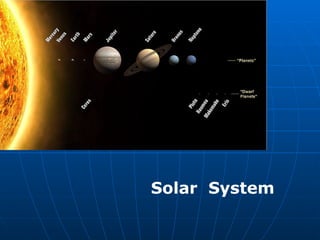Solar System
•Descargar como PPT, PDF•
2 recomendaciones•802 vistas
This is a presentation which provide you the knowledge about the solar system.
Denunciar
Compartir
Denunciar
Compartir

Más contenido relacionado
La actualidad más candente
La actualidad más candente (18)
Destacado
Destacado (14)
Expanding Our Reach Into the Solar System by Prof. G. Scott Hubbard

Expanding Our Reach Into the Solar System by Prof. G. Scott Hubbard
Dr Lewis Dartnell: 'Astrobiology – The hunt for alien life'

Dr Lewis Dartnell: 'Astrobiology – The hunt for alien life'
Celestial bodies in the Solar System: the Sun, planets, satellites, comets, a...

Celestial bodies in the Solar System: the Sun, planets, satellites, comets, a...
Similar a Solar System
Similar a Solar System (20)
YEAR 9 GEOGRAPHY - ASTRONOMY: SUN, PLANETS AND GALAXY

YEAR 9 GEOGRAPHY - ASTRONOMY: SUN, PLANETS AND GALAXY
MOONS OF THE SOLAR SYSTEM (an outline of moons in the solar system)

MOONS OF THE SOLAR SYSTEM (an outline of moons in the solar system)
Último
Último (20)
Kodo Millet PPT made by Ghanshyam bairwa college of Agriculture kumher bhara...

Kodo Millet PPT made by Ghanshyam bairwa college of Agriculture kumher bhara...
ICT role in 21st century education and it's challenges.

ICT role in 21st century education and it's challenges.
On National Teacher Day, meet the 2024-25 Kenan Fellows

On National Teacher Day, meet the 2024-25 Kenan Fellows
Food safety_Challenges food safety laboratories_.pdf

Food safety_Challenges food safety laboratories_.pdf
Unit-V; Pricing (Pharma Marketing Management).pptx

Unit-V; Pricing (Pharma Marketing Management).pptx
Salient Features of India constitution especially power and functions

Salient Features of India constitution especially power and functions
Solar System
- 1. Solar System
- 2. The Sun
- 3. The Sun, a huge sphere of mostly ionized gas, supports life on Earth. The Sun is 332,900 times more massive than Earth and contains 99.86 percent of the mass of the entire solar system.
- 4. Planets
- 5. Mercury
- 6. Mercury is the nearest planet from the Sun. Its orbit period was 88 days and so one side was permanently facing away from the Sun. Its diameter is 4878 km. Its distance from Sun is 57.8 million km.
- 7. V E N U S
- 8. Venus is the second planet from the sun. Its name comes from roman goddess of beauty & love. Its diameter is 12,104 km. Its average distance from the sun is 108.2 million km.
- 9. Earth
- 10. The Earth is the third closest planet to the Sun. It is the only planet where the live happens. It consists Nitrogen (around 78%), followed by Oxygen(21%) and 1% of other gases. Its diameter is 12,756 km.
- 11. Mars
- 12. Mars is the fourth planet from the Sun. It is also known as Red Planet. It has the largest volcanic mountain in the Solar System. Mars has two natural satellites:- Phobos and Diemos.
- 13. Jupiter
- 14. Jupiter is the fifth planet from the Sun. It is the largest planet of the solar system. Its four largest moons are:- IO, Europa, Ganymede, Callisto. Its magnetic field is 20000 times than the earth.
- 15. Saturn
- 16. Saturn is the second largest planet of the solar system. Saturn (the Roman God of Agriculture) has a diameter of 120,000 km. It has more than 30 moons. Its volume is 755 times than the volume of the earth.
- 17. U R A N U S
- 18. Uranus is the seventh planet of the solar system. It is the first planet which is found with the aid of the telescope. It has the 27 moons. Miranda is the strangest looking moon.
- 19. NEPTUNE
- 20. Neptune is both the smallest and the furthest from the Sun. It is the last major gaseous outpost before Pluto and the Kuiper Belt. Neptune is the Roman God of the Sea. Its distance from the sun is the 4,500 million km.
- 22. Pluto is the coldest dwarf planet.
- 23. It is the largest dwarf planet. It has diameter of 3,000 km. It is about 10 billion miles from Sun.
- 24. It is discovered on January 1, 1801. Its name is derived from the Roman Goddess.
- 25. Makemake is a creator god of Rapa Nui (Easter Island). It is the third largest known dwarf planet in the Solar System
- 26. Asteroids are found between belt of Mars and Jupiter. There are more than 90,000 asteroids.
- 27. Meteors are also called Shooting Stars. 10,000 tons meteors are fall on the earth each day.
- 28. Comets take 30 million years to take a trip around the Sun. Each comet has a tiny part nucleus.
- 29. For watching my presentation